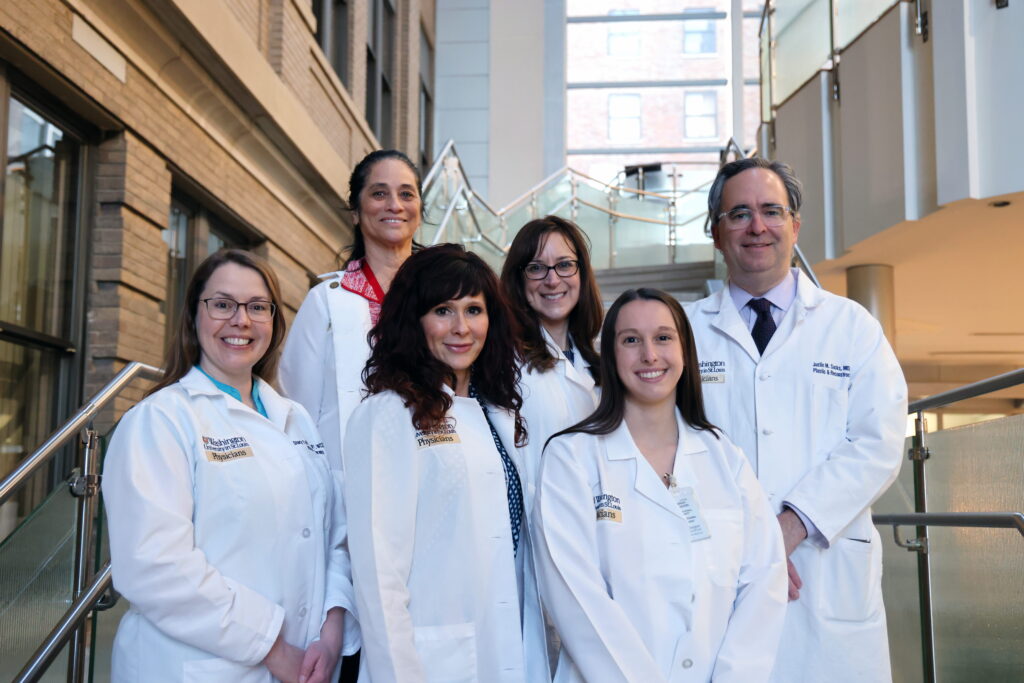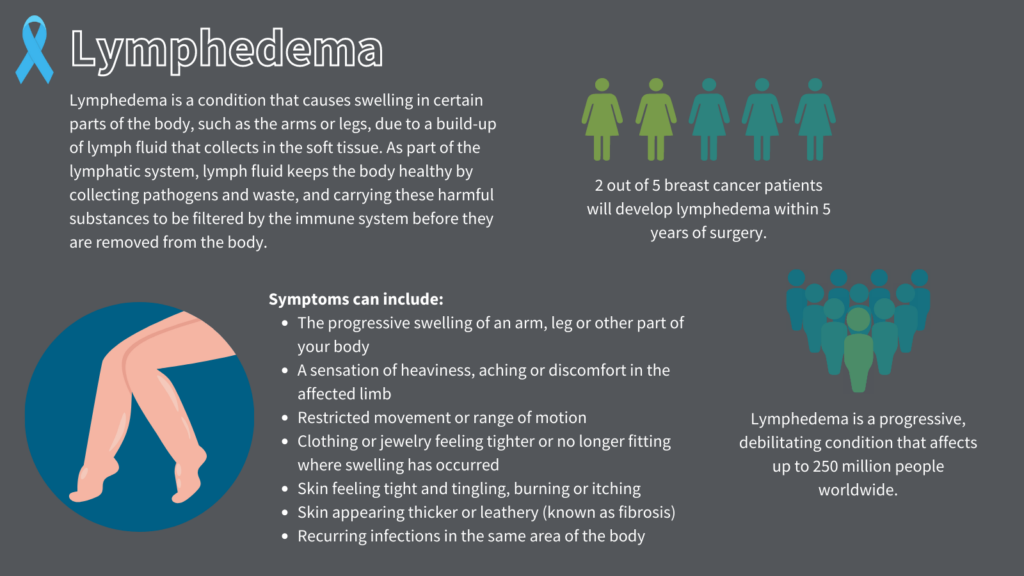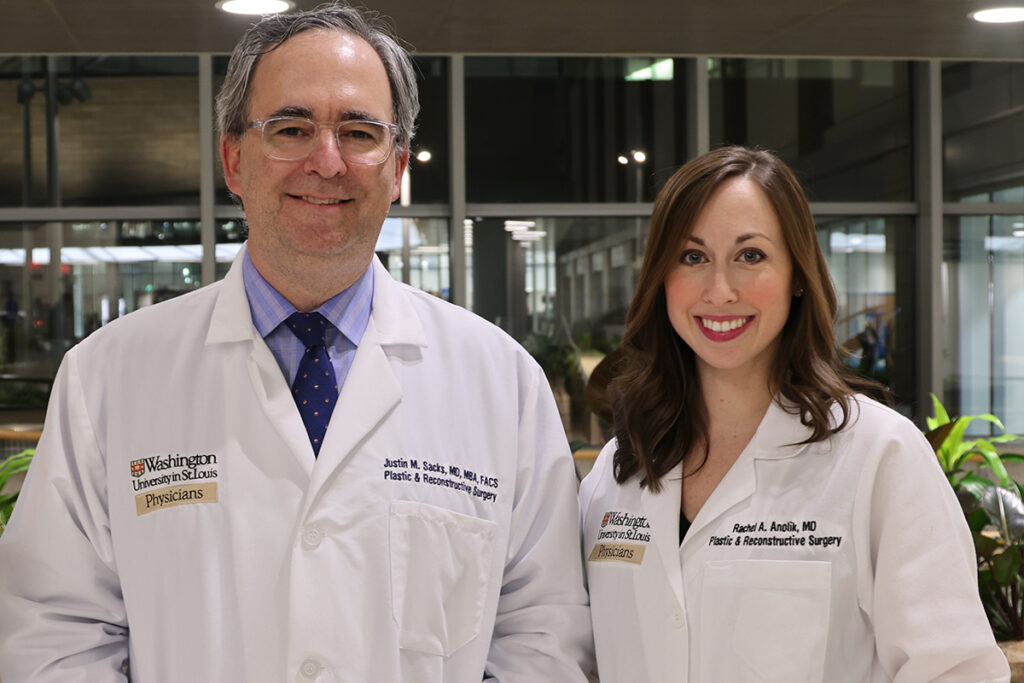Lymphedema can develop when the lymphatic system becomes blocked or damaged. Lymph fluids build up in soft tissues, causing swelling and other symptoms. Cancer treatments, other types of trauma and rare genetic conditions can cause lymphedema. Washington University plastic and reconstructive surgeons in St. Louis are part of a team of specialists who offer the most innovative treatment and management options for lymphedema.
1. The lymphatic system pumps fluid throughout the body.
The lymphatic system is made up of vessels and collecting channels that run throughout the body. The fluid that travels through this system is called lymph. The lymphatic system keeps the body healthy by carrying waste and harmful substances to lymph nodes. These waste products are then filtered by the immune system before they are removed from the body.
The lymphatic system also helps fight off infections. The system surveils (or searches) for germs, foreign materials or anything else that the body would create an immune response to. White blood cells travel through the lymphatic system to help fight toxins, bacteria and viruses.
2. Lymphedema is the build-up of fluid caused by a blockage or damage to the lymphatic system.
Lymphedema happens with lymph fluid becomes blocked and cannot circulate through the body. This build-up of fluid in soft tissue causes swelling in the affected area. Lymphedema is most common in the arms or legs, but can also affect other areas of the body, such as the head and neck.
There are two types of lymphedema: primary and secondary lymphedema.
Primary lymphedema is caused by an inherited condition that affects the development of the lymphatic system. Primary lymphedema can develop in infancy, puberty or even later in life. This type of lymphedema is rare.
Secondary lymphedema is much more common. Secondary lymphedema is caused by trauma to the lymphatic system. In the United States, cancer treatment is the most common risk factor for lymphedema. Surgery, chemotherapy and radiation can disrupt the lymphatic system. Tumors may also block the lymphatic system, resulting in lymphedema.
3. Tests can help detect and diagnose lymphedema before it gets worse.
Most often, people develop lymphedema within about a year after surgery. The symptoms might start to show gradually or have a sudden onset. If left untreated, lymphedema gets progressively worse with time. What that usually means is that the affected area becomes more swollen. Over time, you may notice changes in the skin itself. Skin in the affected area may thicken and grow bumps and sores. This condition is called fibrosis. As lymphedema becomes more severe, people are at increased risk for serious infections in the affected area.
There are several tests doctors can use to determine if swelling is caused by lymphedema. These tests include physical exams and imaging studies. Some imaging studies, like MRI, CT scans and lymphoscintigraphy tests look at the lymphatic system and blood vessels to determine what might be causing swelling.
It is important to talk to a doctor about any swelling or other changes in the affected body part after cancer treatment. Diagnosing lymphedema early on can help prevent the condition from getting worse with time.
4. Certified lymphedema therapists can help you manage lymphedema.
Once a person is diagnosed with lymphedema, the next step is usually to meet with a certified lymphedema therapist (CLT). This is a specially trained physical or occupational therapist who can help you manage your lymphedema. A CLT will perform additional tests, then develop a treatment plan. This treatment plan usually involves wrapping or massage to decrease the volume of the affected limb. Custom compression garments can help reduce the amount of swelling. The CLT team at Washington University School of Medicine in St. Louis takes a prevention approach to lymphedema therapy, managing the condition to stop symptoms from getting worse.

5. If other treatments are not effective, lymphedema surgery may be an option.
Non-surgical management, including manual or pump drainage and compression are the mainstays of lymphedema management treatment. Sometimes lymphedema may still progress or get worse, even with non-surgical treatment. Other people may still have functional lymphatics in other parts of the body. In both cases, there are surgical options that may be able to help with lymphedema.
Vascularized lymph node transfer is a type of physiologic surgery that works directly on the lymphatic system. In this procedure, functional lymph nodes are borrowed from one part of the body and transferred to the area with lymphedema.
Another procedure, called lymphatic bypass surgery, reroutes fluid from a blocked lymphatic vessel into another vein. The surgeon uses a type of imaging technique to determine which vessels are blocked and which are still functioning, then creates a detour to allow lymph to flow with less obstruction.
The goal of these procedures is to improve lymphatic drainage in that area.
For people with more advanced lymphedema and fewer functioning lymphatics, there are debulking procedures, including liposuction and surgical excision. These types of surgery remove the excess fat created by the buildup of fluid. This can make it easier to manage lymphedema using non-surgical treatments in the future.
Because people with advanced lymphedema are at higher risk of infections, the lymphedema treatment team also includes acute care surgeons and wound care specialists. Washington University acute and critical care surgeons, including John Kirby, MD, provide expert wound care to help people with advanced lymphedema get healthy and ready for surgery. These acute care surgeons may also be part of the surgical team involved in large debulking procedures to remove fatty, fibrotic tissue.
6. There are steps to prevent or reduce the risk of lymphedema.
Lymphedema is a progressive condition that affects up to 250 million people worldwide. According to the American Cancer Society, lymphedema is most common for certain cancer types including breast cancer and prostate cancer.
After lymph node dissection or lymph node surgery, there are ways of reducing risk of developing lymphedema. There are also ways of improving the overall course of lymphedema so it does not get worse over time. Some ways to avoid or manage lymphedema include:
- Practice good hygiene.
- Get to or maintain a healthy weight.
- Follow an exercise plan suggested by your doctor.
- Avoid wearing anything that fits too tightly around the affected area.
- Avoid infections, cuts, burns and other forms of trauma.
- Talk to your doctor if you notice any changes in size, color, temperature, feeling or skin condition in the affected area.
There are also new techniques aimed at decreasing the risk of lymphedema after lymph node dissection or other kinds of surgery. One procedure, called immediate lymphatic reconstruction, reroutes lymph fluid past blocked or damaged channels. This allows lymph to flow normally throughout the body, even when part of the lymphatic system has been affected.
7. Not all swelling is lymphedema.
After surgery, some people experience temporary swelling, which will go away with time. Lymphedema is not the only reason someone might experience swelling. Other causes of swelling can include dietary changes, heart or vascular issues, and lipedema. Lipedema is a condition that causes abnormal fat deposits to develop in the lower body. It is important to talk to a doctor if any unusual swelling happens. Catching lymphedema early can improve the chances of managing the condition. Some other causes of swelling can be serious health concerns, which should also be detected and treated quickly.

Washington University Lymphedema Surgery
Treatment for lymphedema requires a multidisciplinary approach. Certified lymphedema therapists, imaging specialists, plastic and reconstructive surgeons, and other health-care professionals work together to provide comprehensive care. Washington University Plastic and Reconstructive Surgery leads an advanced program of lymphedema specialists who offer the most effective and innovative treatment options. Chief of plastic and reconstructive surgery Justin Sacks, MD, MBA, and Washington University surgeon Rachel Anolik, MD are leading experts in the surgical treatment of lymphedema.
Lymphedema surgeons and therapists see patients at the Center for Advanced Medicine and Barnes-Jewish West County Hospital.
For more information about lymphedema treatment or to make an appointment with Dr. Sacks or Dr. Anolik at the Center for Advanced Medicine or Barnes-Jewish West County Hospital, please call 314-362-7388 or request an appointment online.
